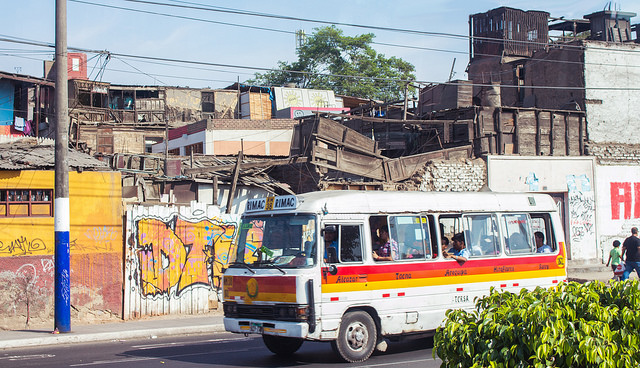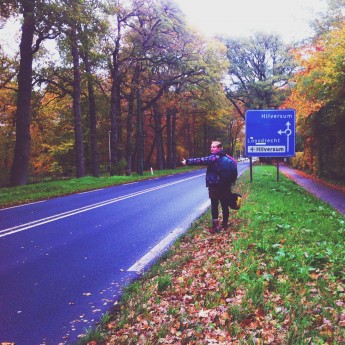
Public transportation isn’t my expertise at all, but over the last few weeks in Lima (writing a new Digital Nomads Guide!) I had to learn and master the art of navigating the Lima City Bus system. A big thanks to Marian Knittler for letting me use his photos for this article. Check out his photography on Flickr.
A little background information: Lima is Perú’s capital city and the metropolitan area is home to about 9 million people. That’s almost one third of the country’s population. Enormous! The city has a very primal and basic metro system that doesn’t really do anything for most people. There’s about one functional line. With a half-assed train reaching only the bare minimum of the city, most Limeños depend on bus transportation for their commute. Sure, there’s taxis and tuktuks (known locally as mototaxis) but hiring a driver for a short distance always leads to a steep price increase.
Conclusion: the taking the city buses is the cheapest and most efficient way to get around town.
Now, if you’re only staying in Lima for a week, it might not be worth the hassle to figure out how the bus system works. But for people who can’t afford to take a taxi to do everything, this is a real money (and time!) saver.
Note about Lima: the city is also so vast, that it’s not really possible to walk between areas of interest. For example: traveling from the Parque Kennedy in Miraflores to the Plaza de Armas in Cercado de Lima is a trip of 10 whole kilometers, interrupted by vast avenues and many detours for pedestrians.
Buses rule in Lima.
What one first has to know about the bus system is that it may look like a total chaos to any visitor. Yes, it would take a lifelong time of commuting before one knows where the bus comes from, where it stops and where it will go to. Don’t bother trying to find a real pattern. You won’t.
There are four types of buses and one special type that deserves a its own category
That last one is the express bus. One example is the 301, 302 and 303, that drive between Cercado and San Isidro to Miraflores. They often have their own bus lane in the middle of the street for rapid transit. They have a sort of subway station style entrance system, where you have to pay before you get in. When you get in via the metro entrance style via a central platform, you’ll be on the left side of the bus and not entering from the right as is usual. They actually built in a special freaking door! The bus has four freaking doors! Two on the right, two on the left. This also means that the buses on these lines were custom made, which in turn means that they are newer and more organized than all the rest of the Lima city bus fleet.
The four types
The other types can be divided by size. The size doesn’t indicate how far it goes or in which districts it stops. The smaller the bus, the more it stops. Yes, the super-small one will stop anywhere for picking up people. The bigger ones are more confined to actual designated bus stops (paraderos). The smaller ones fit about 17 people. Two of the seats are next to the driver and you’ll have to enter via the passenger door or climb over the middle. Basically, they are just minivans, but very long ones. You’ll have to tell the person who gets your money (cobrador) when and where you’ll get out. This guy just stands in the bus all day, sells tickets and opens and closes the door. Often while driving and shouting random destinations at innocent bystanders. Get used to it: you’re in South America.

Looks may deceive: this guy actually helps the old people get in the van.
Size number two is a slightly larger bus than bus type number one, but actually starts taking the shape of an actual fucking bus. This one only has a front entrance and no back exit. They almost always have a cobrador who comes to take your money. Sit in the back of the bus and you’re going to have a sore butt. Every time you drive over a speed bump you’ll get launched into the air, as they don’t really slow down for those.

Lima city bus size number three starts really looking like a real bus – and often it is. It has a front entrance and a back exit. There’s again often a person who will shout destinations before you get in and take your money when you’re seated.

The final bus type is the largest one and has two doors, front and back. There is possibly a chofer cobrador, which means that the driver accepts your money for the trip and there’s no colleague. This means you will have to have your money ready upon entering the bus. The guy doesn’t like it when you first find a seat and then walk forward again to pay the guy. I don’t know why they saved the job of the money guy in the biggest bus size. It doesn’t make any logical sense to burden the driver of the large vehicle with also issuing small change. This bus has the highest chance of having a button to indicate your departure. Some of them are very old, others are quite new and shiny.
Very important notes on Lima city bus etiquette
Every bus has special seats for senior/pregnant/disabled/with child citizens. Watch out for the red chairs. If not marked with a different color, there’s a sticker on the window next to the seats to indicate its not for able-bodied people. The people in Perú really respect these rules and also expect you to follow these. You can sit here, but if someone that fits the description comes in, you’ll have to give up your seat or face public shaming. Its better to move a little to the back so you can hold on to your seat indefinitely.

People in Perú tend to take up space. On the bus, if there is two empty seats next to each other, a Peruvian person will typically sit on the one next to the aisle, essentially blocking access to the window seat. I don’t know why they do this, but it awkwardly puts the burden of asking if it’s OK to sit next to a person on the individual standing (and struggling to keep standing as the bus drives like crazy). How to get a seat? Ask the person “Puedo sentarme aca aqui por favor? and then they should let you sit. Otherwise you’re dealing with an extreme asshole and I’m so sorry for that.
Around certain bus stops are people with clipboards hanging about and communicating to the cobradores or bus drivers. They scribble down numbers all day long. At first I thought they are some kind of conspiracy theorists trying to decipher something according to bus times and numbers, a sort of low-tech version of number stations. It turns out they’re actually vital to the Lima city bus system as none of it is regulated. Their job title? Datero. These freelancers make sure the bus drivers know whether to speed up or slow down and whether it’s a busy day. Don’t ask them to help you find your bus though, as they’re keeping track of multiple bus lines at the same time and that takes up enough head space.
While waiting for the bus, you might give up. Especially as there’s taxis beeping a honking at you every time because you are waiting next to the road and perhaps even look like a foreigner. You should not go with them when you plan on taking the bus. They feed on the idea that you have no clue where you are going. Also, they will drop you off in Miraflores, because that is where the tourists stay, even when you explicitly tell them you need to go to a different district. They do not deserve your business. They are roaming the city all day long, pumping CO2 into the atmosphere and contributing to Lima’s traffic and noise problems. All that on the off chance someone might need their services.
Tuktuks essentially do the same, but they have a smaller impact. Tuktuks also aren’t allowed in every district as a form of public transportation, therefore they will mostly go shorter distances.
Making sense of it all: get yourself an app
Now to know which bus to take, I’ll need to state the obvious: you need to know where you are and where you are going!
This requires at the very least GPS and a downloaded map (I recommend OSM+) and/or mobile internet. You might want to invest in mobile internet. If you don’t have a smartphone or a tablet you are going to have a hard time finding the bus. On analog navigation there is more information below.
Do you have Android? Then download the TuRuta app in the Play Store. This is something that is going to make your navigation simply easy peasy. You can select Spanish and English. Put in your location or let the GPS take care of that, then put in your destination (which can be a street address, but also a landmark, like Parque Kennedy or Statue of John Lennon). It also knows big self-important buildings that carry their own name. Press enter and the app will give you a couple of bus route suggestions. Take whichever fits you best.


The app has pictures of the buses too – which is kind of amazing! This will help you determine which of the four types it is. If you’re moving through town with a big backpack, it’s better to take a route that involves a bigger bus. This way you won’t hit people in the face with your luggage. Easy karma points. Mind you, the bus stop location really matters for the bigger buses.
Now to use the app, you should know that all buses in Lima have two codes. One is alphanumeric and the other is just numeric. Both consist of four characters. Tricky shit incoming: what you see might not be what you get! There are – I shit you not – nicknames for buses… Just remember the right codes of the bus, print screen them on your device, save it in a note, or write it on a piece of paper.
If you put in the route and let the app stay open during your journey, it will warn you on time to get out at your stop by sounding your wake-up alarm on your mobile device. Yeah it’s a weird functionality that still needs some tweaking. Don’t depend on this function though, because your phone might not be able to get an accurate GPS signal to track your route.
The price of your trip depends on the distance, but you’ll never find the pattern. You don’t know the “zones”, but the money person on the bus does. Give an indication of where you are going, and it’s likely that s/he will also help you get off the bus on time as a part of their service. Again, don’t rely on this. People are generally very helpful on the bus to make the foreigner find their way. I’ve never paid fares of more than 1 Nuevo Sol (PEN) ($0.31/€0.27), so if you have shitty coins bring ’em, they are happy with them. You’d also be frowned upon using anything bigger than a 5 Soles coin!
How is it to ride the bus alone as a woman?
OK I guess? In my five weeks of crisscrossing the city by bus, I never got assaulted, but my experience is no guarantee for yours. The most awkward experience I had was when I took the bus out of the city to start hitchhiking again. I sat next to the driver and a woman sat in between us on the gear bulge. She went on a total rant to me about how dangerous the city is. She told me I’d get robbed “or worse” in broad daylight and Peruvians wouldn’t care about my suffering, blah blah. I tried to counter it by telling her I’ve had really great experiences in both Lima and Perú in general, but she wouldn’t let me have it…
So there you have it, my worst experience on the Lima city bus was because of an older woman…
Enjoyed this? Pin me! 😀


























Hola Iris:
I´ve just read your article and i found it very hepful for foreigners. I´m a peruvian. And it is very interesting to read about the peruvian bus system from a different point of view. I think you have captured the reality of this chaotic aspect of my city. Haha. It´s funny too.
And i am happy you are relaxed about the safety. Many times i hear peruvians telling to foreigners about the dangerous levels of Lima. But i feel it´s not necessary to be too dramatic.
I hope you keep on having good experiences here.
Good Luck
Hey Edu thanks for your comment! 🙂 My experiences in Perú were absolutely great, and as I travel haciendo dedo I’ve been around locals more than fellow gringos. Many of the friendly Peruvians who have given me a ride or talked to me warned me about the dangers. People would always warn me about the place I was traveling to, whether that was from Magdalena del Mar to Pueblo Libre or in the other direction. I think many Peruvians think it must be very scary for me (and other visitors) to be in a foreign country. I think many Peruvians also think that taking the bus in for example Europe must be a lot safer and more organized.. (but it’s not!) Maybe they are just trying to manage the expectations of foreigners, but I think the citizens of Perú can be proud of their welcoming country. Even when their bus system is so intimidatingly large and seemingly disorganized 😉
Glad to hear that. I always love to talk to foreigners and travellers who visit my country.
And apart from this, tomorrow i will use your article to practice my english pronunciation with a language partner (from usa) by Skype. This article will give him an idea about an aspect of the peruvian culture. Additionally in this way i can share your blog for future visitors who come to Lima.
Hey Iris!
Peruvian hitchhiker here, ended up on your web because I was updating some info on the hitchwiki (thanks for your info there!) and got into this funny description about Lima bus system, yeap, it is crazy, I prefer to ride my bicycle around (it’s quite dangerous but I can’t stand being locked in the bus).
People here will often tell you how dangerous everything is, and I agree but only for Lima and certain areas, basically if you use common sense everything will be ok.
It is a shame that you ended up in a colectivo when you were going East of Lima, actually I go there quite ofter for climbing and always ask myself if it would be possible to catch a ride there.
Your stories are very cool, keep enjoying South America! If you ended up in Lima again, please let me know!!!
Pdt: Never made it to your country tho once in the Bulgaria-Turkey border I catch a ride that was going straight to The Netherlands, 3 days non-stop but I got out at Belgrade to visit friends :D.